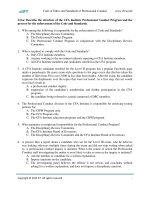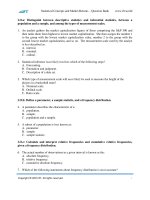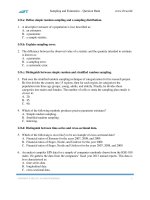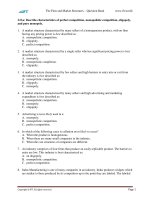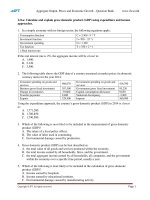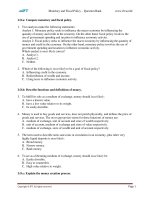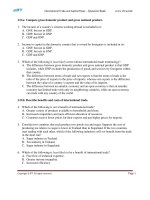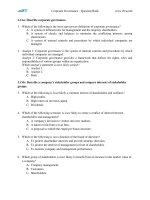CFA 2018 quest bank r01 ethics and trust in the investment profession q bank
Bạn đang xem bản rút gọn của tài liệu. Xem và tải ngay bản đầy đủ của tài liệu tại đây (187.8 KB, 5 trang )
Ethics and Trust in the Investment Profession
www.ift.world
LO.a: Explain ethics.
1. Standards of conduct can be least likely described as:
A. a set of principles that define rules for acceptable and forbidden behaviour.
B. minimal acceptable behaviour expected of members of a community.
C. a set of principles that define the legal boundaries of a community.
2. Which of the following statements is most likely correct?
A. Ethics can be described as a set of moral principles that provide guidance for our
behaviour.
B. Ethical conduct is behaviour that balances one’s own interest with only the direct
consequences of the behaviour on others.
C. Professional associations adopt a code of ethics to protect their own professional
community.
LO.b: Describe the role of a code of ethics in defining a profession.
3. A profession can be best described as:
A. work done to earn a livelihood in the short-term.
B. a job that requires specialized skills, is based on the service to others and requires
adherence to a code of ethics.
C. a job to which one is well suited.
4. Which one of the following is a least likely reason for a profession to establish a code of
ethics?
A. A code of ethics serves as an aid in decision-making.
B. A code of ethics helps instil confidence among clients and prospective clients.
C. A code of ethics helps ensure that members of the profession will follow the law.
5. Which one of the following statements most likely differentiates clients from customers?
A. A client’s relationship is transactional in nature whereas a customer uses the services
of a professional on an ongoing basis.
B. A customer’s relationship is limited to small transactions whereas a client engages in
relatively large transactions.
C. A customer’s relationship is transactional in nature whereas a client uses the services
of a professional on an ongoing basis.
LO.c: Identify challenges to ethical behavior.
6. Which of the following is least likely a challenge faced by professionals to display ethical
behaviour?
A. People tend to believe they are more ethical than they actually are.
B. People tend to underestimate their own morality.
C. People tend to underestimate the impact of situational influences.
7. Which of the following statements is most likely correct?
A. Money and prestige prod people to act in their own self-interests and take actions that
are less ethical.
Copyright © 2016 IFT. All rights reserved.
1
Ethics and Trust in the Investment Profession
www.ift.world
B. Loyalty to employer and colleagues can only have a positive effect on one’s ethical
behaviour.
C. Processes focused solely on compliance simplify decision making and help the larger
cause.
LO.d: Describe the need for high ethical standards in the investment industry.
8. Which of the following statements is least likely accurate? Trust is particularly important
in the investment profession because:
A. investment professionals have specialized knowledge and access to information is
asymmetrical.
B. products and services in the investment industry tend to be intangible.
C. returns cannot be guaranteed for most types of investments.
9. Which of the following statements is most likely accurate?
A. Ethical firms are subject to higher costs as compared to less ethical firms.
B. Investors expect a lower return on their capital when they lose trust.
C. Lack of trust in financial markets can lower investments consequently harming
society.
LO.e: Distinguish between ethical and legal standards.
10. Which of the following is most likely a good example of ethical conduct?
A. Make appropriate choices even in the absence of clear laws.
B. Restrict one’s behaviour to what is legally acceptable.
C. Make sensible decisions that minimize the risks to one’s employer only.
11. Which of the following is least likely a reason for laws being insufficient to ensure ethical
conduct among market participants?
A. Laws can be interpreted differently.
B. Laws are largely the same across jurisdictions.
C. Passing a law takes significant time.
LO.f: Describe and apply a framework for ethical decision making.
12. Which of the following statements about ethical decision framework is/are most likely
accurate?
Statement 1: An ethical decision framework helps decision makers justify actions
to stakeholders.
Statement 2: Too many choices can at best lead to inaction.
Statement 3: An ethical decision framework serves as a tool for investment
professionals to choose the best possible alternative.
A. Statement 1 and 3.
B. Statement 3 only.
C. Statement 1, 2 and 3.
13. Which of the following parties should an investment professional consider as
stakeholders while making decisions in an ethical manner?
A. Employer and clients only.
Copyright © 2016 IFT. All rights reserved.
2
Ethics and Trust in the Investment Profession
www.ift.world
B. Clients and market participants only.
C. Employer, clients, family and market participants.
14. Which of the following would be a step in the consideration phase in an ethical decisionmaking process?
A. Assess the decision to see if it had the desired outcome.
B. Seek guidance to navigate through situational influences.
C. Assess any potential conflicts of interest.
Copyright © 2016 IFT. All rights reserved.
3
Ethics and Trust in the Investment Profession
www.ift.world
Solutions
1. C is correct. Standards of conduct can sometimes be different from what is stated in the
law. Statements A and B are accurate descriptions of standards of conduct.
2. A is correct. Statement B is incorrect because ethical conduct is behaviour that balances
one’s own interest with the direct and indirect consequences of the behaviour on others.
Statement C is incorrect.
3. B is correct. A profession is a type of job that 1) requires specialized training and skills,
2) is based on service to others, and 3) is practiced by members who share and adhere to a
common code of ethics.
4. C is correct. The code of ethics cannot ensure that members of the profession will follow
the law. Statements A and B are true.
5. C is correct. Clients differ from customers. A customer is one who engages in a single or
a series of transactions to buy a good or service. The relationship is transactional in
nature. A client, on the other hand, uses the services of a professional for his knowledge
and skills on the subject on an ongoing basis, for a fee.
6. B is correct. Challenges faced by professionals to display ethical behaviour include: 1)
overestimating one’s morality and 2) underestimating the effect of situational influences.
7. A is correct. Statement B is incorrect because loyalty can have both positive and negative
effects towards one’s behaviour. Statement C is incorrect because processes focused
solely on compliance oversimplify decision making and that does not necessarily help the
larger cause.
8. C is correct. Statement A and B are valid reasons for trust being important in the
investment profession. C does not represent a reason for why trust is particularly
important in the investment industry.
9. C is correct. Statement A is incorrect because ethical firms enjoy lower costs as they are
not subjected to investigations by regulators. Statement B is incorrect because when
investors lose trust, they expect higher returns for their capital, which in turn increases the
cost for borrowers.
10. A is correct. Statement B is incorrect because ethical conduct requires a professional to
go beyond what is legally required. Statement C is incorrect because a professional
should minimize the risks of all stakeholders such as the employer, clients, family, and
market participants.
11. B is correct. Laws can vary across jurisdictions. This may encourage questionable
practice to move to places that are less restrictive in nature. Statements A and C are valid
reasons for why the law alone might be insufficient to ensure ethical behaviour.
12. C is correct. All three statements regarding ethical decision frameworks are correct.
Copyright © 2016 IFT. All rights reserved.
4
Ethics and Trust in the Investment Profession
www.ift.world
13. C is correct. An investment professional should consider the risk to all stakeholders such
as employer, clients, family, and market participants while making decisions.
14. B is correct. Statement A is a step once the decision is already made and Statement C is a
step in the identification phase of the ethical decision-making process.
Copyright © 2016 IFT. All rights reserved.
5

